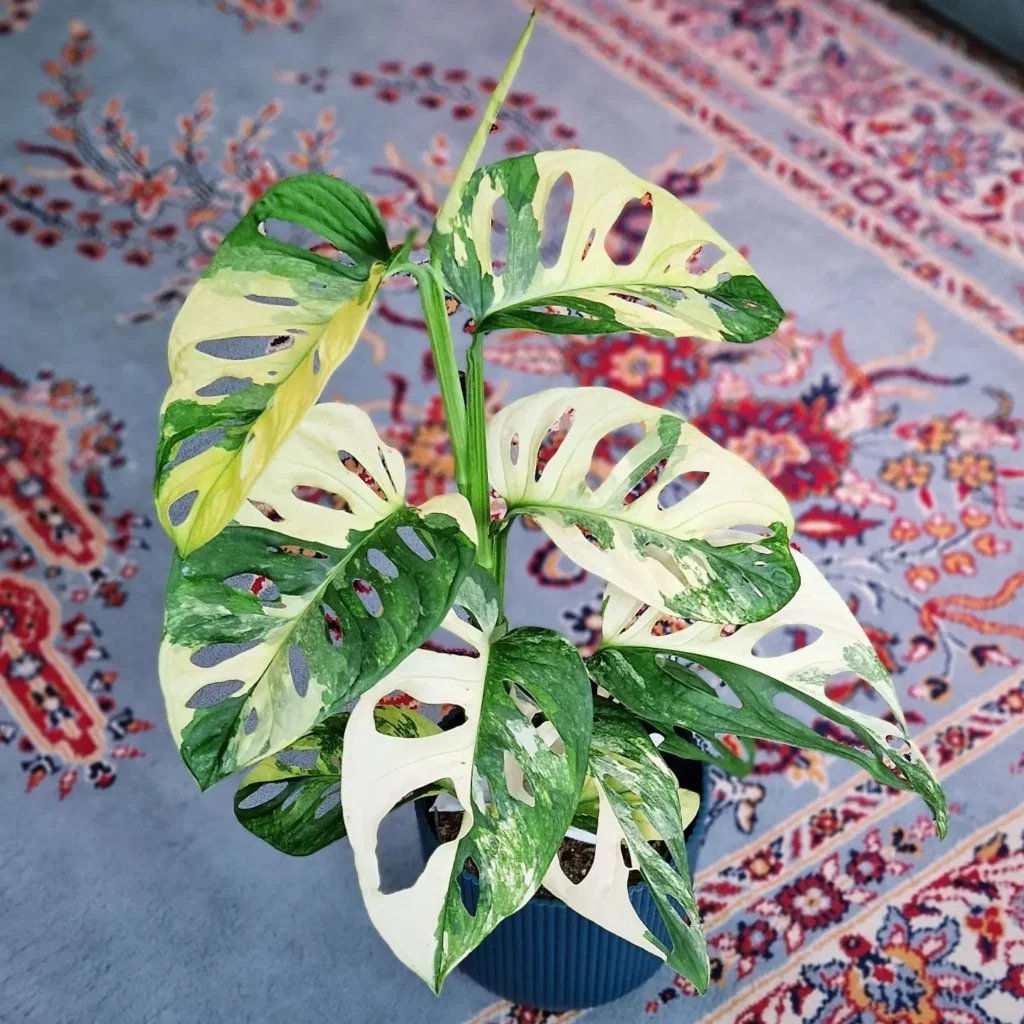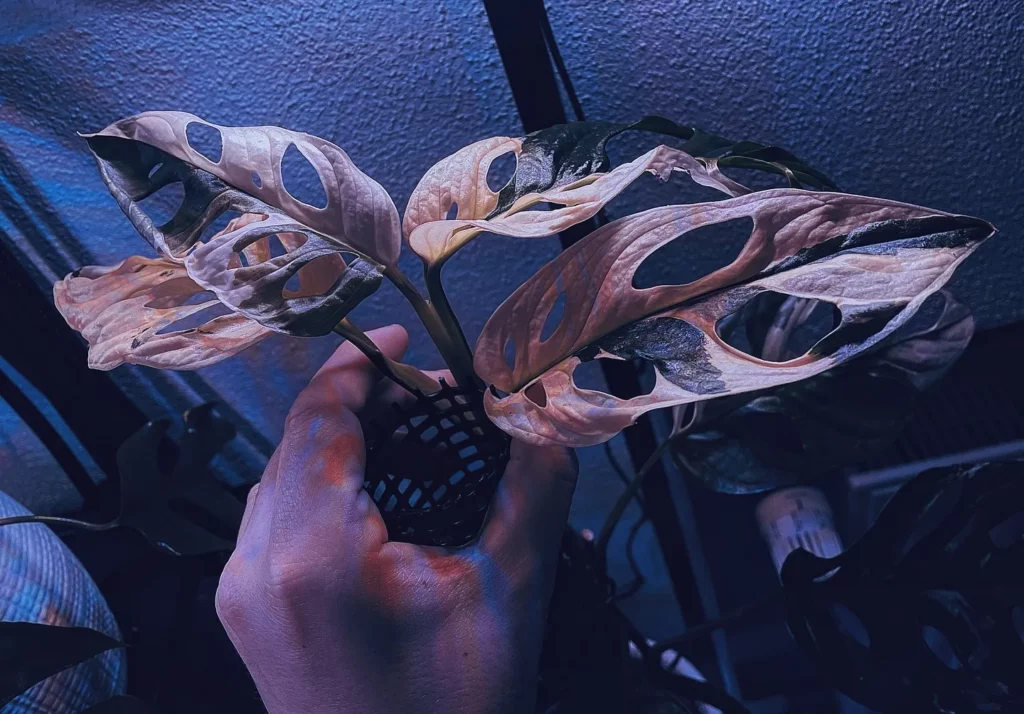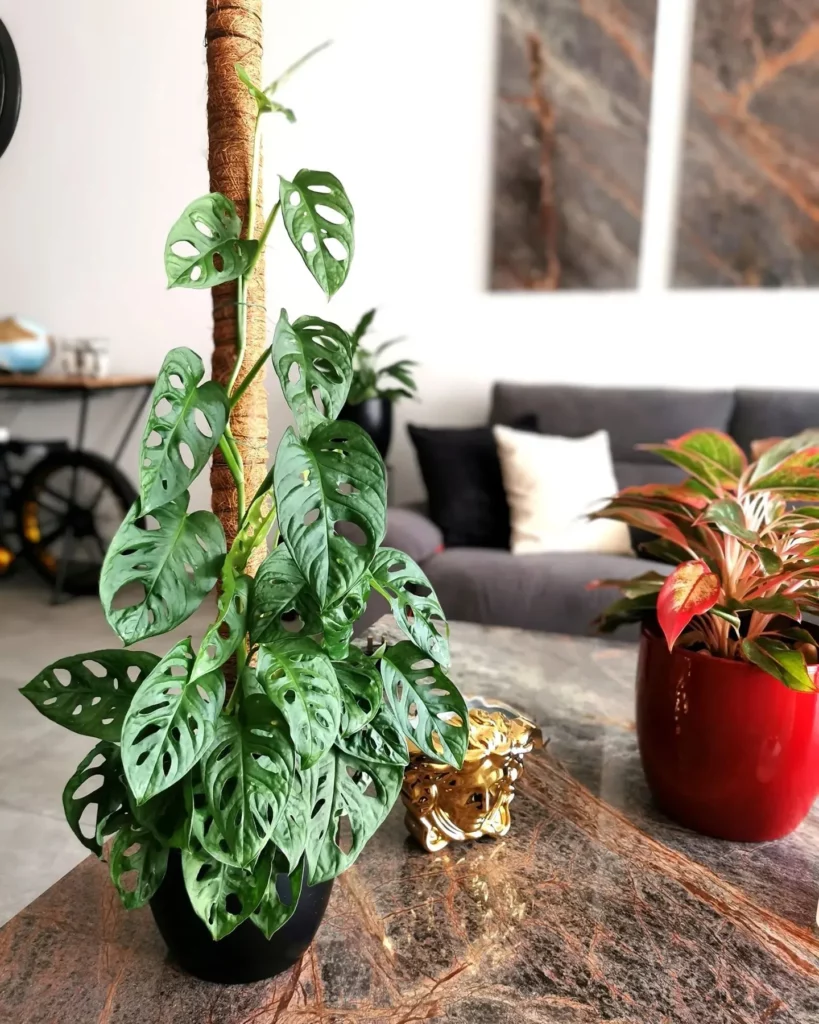Welcome to the ultimate care guide for Monstera adansonii, commonly known as Swiss Cheese Vine. This popular trailing houseplant features stunning cut-out foliage that adds a touch of quirkiness and charm to any indoor space. Caring for your Monstera adansonii is a breeze, and with the right tips, you can ensure its health and vitality.
Key Takeaways:
- Monstera adansonii, also known as Swiss Cheese Vine, is a popular trailing houseplant with unique cut-out foliage.
- Provide your Monstera adansonii with bright, indirect light to promote optimal growth.
- Water your Monstera adansonii when the top half to three-quarters of the soil mix is dry, adjusting the frequency based on environmental conditions.
- Fertilize your Monstera adansonii during the growing season using a balanced houseplant fertilizer.
- Repot your Monstera adansonii every 2-3 years using a well-draining potting mix.
Appearance of Monstera adansonii

Monstera adansonii is a visually striking houseplant that is sure to grab attention wherever it is placed. What sets this plant apart is its unique foliage, characterized by its beautiful fenestrations or leaf perforations. These captivating cut-outs give the plant its popular nickname, Swiss Cheese Vine.
As the plant matures, its leaves grow larger, showcasing even more intricate patterns of fenestrations. The foliage of Monstera adansonii adds a touch of whimsy and charm to any indoor space, making it a favorite choice among plant enthusiasts.
The appearance of Monstera adansonii:
- Unique and visually striking foliage
- Fenestrations or leaf perforations
- Intricate patterns on larger leaves as the plant matures
- Adds charm and whimsy to indoor spaces
No products found.
Light Requirements for Monstera adansonii



Proper lighting is essential for the healthy growth of your Monstera adansonii, also known as Swiss Cheese Vine. Here are some guidelines to ensure you provide the right amount of light for your indoor plant.
- Bright, indirect light: Monstera adansonii thrives in bright, indirect light. Place your plant near a window where it can receive moderate exposure to natural light. Avoid placing it directly in front of a window, as this can lead to excessive light exposure and potential leaf scorching.
- Avoid direct sunlight: While Monstera adansonii can tolerate some direct sunlight, it is best to avoid intense afternoon sun. Direct sunlight can cause the leaves to develop brown marks and can harm the overall health of your plant.
- Dappled or filtered sunlight: Providing dappled or filtered sunlight is an ideal option for meeting Monstera adansonii’s light requirements. This can be achieved by using sheer curtains, blinds, or placing the plant in a location where it receives indirect light through a tree canopy.
Creating the Ideal Environment
In addition to light, other environmental factors play a crucial role in the well-being of your Monstera adansonii. Consider the following tips to create the ideal environment for your indoor plant:
- Temperature: Monstera adansonii prefers warm temperatures between 65-85°F (18-29°C) during the active growth period. However, it can tolerate slightly cooler temperatures in the range of 60-75°F (15-24°C) during the winter months.
- Humidity: Maintain a humidity level of around 50-60% to replicate the plant’s natural tropical habitat. You can increase humidity by misting the leaves, using a humidifier, or placing the pot on a tray filled with water and pebbles.
- Air circulation: Good air circulation is important to prevent stagnant air and promote healthy growth. Place your Monstera adansonii in a well-ventilated area away from cold drafts and ensure proper airflow around the plant.
Watering Monstera adansonii



Proper watering is essential for the health and well-being of your Monstera adansonii, also known as Swiss Cheese Vine. By following these watering guidelines, you can ensure that your indoor plant thrives and remains vibrant.
1. Know when to water: Water your Monstera adansonii when the top half to three-quarters of the soil mix is dry. Stick your finger about an inch into the soil to check the moisture level. If it feels dry, it’s time to water.
2. Water thoroughly: When watering, ensure that you thoroughly moisten the soil. Water until it drains out of the pot’s bottom, but make sure to discard any excess water in the saucer. This prevents the roots from sitting in water, which can lead to root rot.
3. Consider environmental factors: Adjust your watering frequency based on factors such as pot size, soil type, location, and environmental conditions. For example, plants in smaller pots may need more frequent watering, while those in larger pots may require less.
Signs of overwatering and underwatering:
- Overwatering: If you notice yellowing leaves, soft or mushy stems, or a foul odor coming from the soil, you may be overwatering your Monstera adansonii.
- Underwatering: Symptoms of underwatering include dry, crispy leaves and a drooping or wilted appearance. The soil may also pull away from the edges of the pot.
Fertilizing Monstera adansonii
Proper fertilization is essential for the healthy growth and development of your Monstera adansonii, also known as Swiss Cheese Vine. Fertilizers provide your plant with the necessary nutrients to thrive and maintain its vibrant foliage. Here are some key tips for fertilizing your Monstera adansonii:
1. Choose the right fertilizer:
Select a balanced liquid or granular fertilizer specifically formulated for houseplants. Look for a fertilizer with equal amounts of nitrogen (N), phosphorus (P), and potassium (K). These three macronutrients promote healthy foliage, root growth, and overall plant vigor.
No products found.
2. Follow the manufacturer’s instructions:
Read and adhere to the instructions provided by the fertilizer manufacturer. Pay attention to the recommended dosage and frequency of application. Over-fertilization can harm your Monstera adansonii, so it’s important to follow the instructions carefully.
3. Apply during the growing season:
Fertilize your Monstera adansonii every 4-6 weeks during the growing season, which typically spans from spring to early fall. This is when your plant is actively growing and requires additional nutrients to support its growth.
4. Avoid fertilizing in winter:
During the winter months, Monstera adansonii enters a period of rest. It’s best to refrain from fertilizing during this time, as the plant’s growth slows down. Instead, focus on maintaining proper watering and providing adequate light and humidity.
Potting Monstera adansonii
Proper potting is essential for the growth and development of your Monstera adansonii, also known as the Swiss Cheese Vine. Here are some important tips to ensure your plant thrives in its new home:
1. Choosing the Right Pot
Select a pot that is slightly larger than the current one to allow room for root growth. A pot with drainage holes is crucial to prevent water retention and root rot. Terra cotta or ceramic pots are excellent choices as they provide adequate air circulation.
2. Using the Right Soil
Monstera adansonii prefers a well-draining potting mix. You can create a suitable mix by combining equal parts of peat moss, perlite, and a good quality indoor plant potting soil. This mix promotes healthy root growth and prevents waterlogged conditions.
3. Repotting Technique
To repot your Monstera adansonii, gently remove it from its current pot, being careful not to damage the roots. Place a layer of fresh potting mix at the bottom of the new pot, position the plant in the center, and fill the remaining space with more potting mix. Firmly press down the soil to ensure stability.
4. Post-Potting Care
After potting, thoroughly water your Monstera adansonii to settle the soil. Keep the plant in a well-lit area, but away from direct sunlight. Monitor the moisture levels and water only when the top inch of soil is dry. Avoid overwatering, as it can lead to root rot.
Propagation of Monstera adansonii
If you’re looking to expand your Monstera adansonii collection or share this beautiful plant with others, propagation is a great option. There are two common methods to propagate Monstera adansonii: stem cuttings and division.
Stem Cuttings
To propagate Monstera adansonii using stem cuttings, start by selecting a healthy stem with at least two nodes. Nodes are the points on the stem where leaves and aerial roots emerge. Using a clean, sharp pair of scissors or pruning shears, make a clean cut just below a node. Remove any leaves from the lower portion of the cutting, leaving a few at the top to aid in photosynthesis.
Place the cutting in a glass of water or a light potting mix, ensuring that the nodes are submerged or in contact with the soil. Keep the cutting in a warm and bright location, away from direct sunlight. Within a few weeks, you should start to see roots emerging from the nodes. Once the roots are well-established, you can transfer the cutting to a pot filled with well-draining soil.
Division
If your Monstera adansonii has grown into a larger plant with multiple stems, you can propagate it through division. Gently remove the plant from its pot and separate the individual stems, ensuring that each section has its own set of roots. If needed, you can use a clean, sharp knife or scissors to carefully separate the stems.
After dividing the plant, pot each stem into its own container filled with well-draining soil. Water the newly potted stems thoroughly and place them in a warm and bright location. With proper care, each divided stem should continue to grow and develop into a new Monstera adansonii plant.
Propagation is a rewarding way to expand your collection of Monstera adansonii or share this stunning plant with others. Whether you choose to propagate through stem cuttings or division, be patient and provide the right conditions for success. With a little care and attention, you’ll soon have more Monstera adansonii plants to enjoy and admire.
Growth and Development of Monstera adansonii
Monstera adansonii is a fast-growing plant that can add a touch of lush greenery to your indoor space. With proper care, this Swiss Cheese Vine can develop trailing vines that can reach up to 10-15 feet indoors and even up to 50 feet outdoors. As the plant matures, its leaves also grow larger, showcasing the unique fenestrations that give it its common name. The rapid growth and striking appearance of Monstera adansonii make it a popular choice among plant enthusiasts.
To encourage the growth and development of your Monstera adansonii, it’s essential to provide it with the right conditions. This includes ensuring it receives bright, indirect light, as well as maintaining a consistent watering routine. Adequate fertilization during the growing season can also support its growth. Additionally, be mindful of potting and repotting your plant, as a well-drained potting mix and appropriate pot size contribute to healthy root development.
Promoting Growth Tips:
- Place your Monstera adansonii in a location with bright, indirect light to encourage vigorous growth.
- Fertilize your Monstera adansonii every 4-6 weeks during the growing season with a balanced houseplant fertilizer.
Managing Pests and Diseases in Monstera adansonii
Keeping your Monstera adansonii healthy and free from pests and diseases is vital for its growth and overall well-being. While these plants are generally resistant, they can still be susceptible to common houseplant pests and diseases. Here are some essential tips to help you effectively manage these issues:
1. Regularly inspect your plant
- Check both the upper and lower surfaces of the leaves, stems, and the soil for any signs of pests or diseases.
- Look out for common pests such as mealybugs, scale insects, and spider mites. These pests can cause damage to the leaves and weaken the plant.
- Additionally, keep an eye on the overall appearance of your Monstera adansonii. Any changes in color, texture, or growth patterns could indicate an underlying issue.
2. Take immediate action against pests
- If you spot any pests, isolate the affected plant to prevent the infestation from spreading to other plants.
- Use appropriate organic or chemical pest control methods to eliminate the pests. Follow the instructions on the product label carefully to ensure the safety of your plant.
- Consider using natural remedies like neem oil or insecticidal soap, which can effectively control common pests without harming your Monstera adansonii.
3. Maintain good plant hygiene
- Regularly clean the leaves of your Monstera adansonii using a damp cloth or sponge to remove dust and debris. This will help prevent pests from finding a cozy hiding spot.
- Remove any fallen leaves or plant debris from the soil surface to discourage pests from breeding.
- Avoid overwatering your plant, as excess moisture can create a favorable environment for pests and diseases.
How to Care for Monstera adansonii during Winter
During the winter months, it is important to adjust your care routine for your Monstera adansonii to ensure its health and well-being. Here are some essential tips for winter care:
Moderate Watering:
Reduce the frequency of watering during winter as the plant enters a period of dormancy. Allow the top inch or two of the soil to dry out before watering. Overwatering can lead to root rot, so it’s crucial to strike a balance and ensure proper drainage.
Maintain Stable Temperature:
Keep your Monstera adansonii away from cold drafts and maintain a stable temperature. It prefers slightly cooler temperatures during winter, but avoid exposing it to extreme cold or fluctuations that can harm the plant.
Monitor Humidity Levels:
Indoor heating can cause the air to become dry, which can adversely affect your Monstera adansonii. Maintain a humidity level of around 50-60% by misting the leaves, using a humidifier, or placing the pot on a tray with water and pebbles. This will help mimic its natural tropical environment.
Final Thoughts on Growing Monstera adansonii
Congratulations on taking the first step towards successfully growing Monstera adansonii, also known as Swiss Cheese Vine. This charming houseplant with its unique foliage is a wonderful addition to any indoor space. By following these final tips, you can ensure that your Monstera adansonii thrives and stays healthy.
Make sure to provide your Monstera adansonii with the right care. Pay attention to its light requirements and place it in a spot with bright, indirect light. Avoid direct sunlight, as it can damage the leaves. Additionally, water your plant properly, allowing the soil to partially dry out before watering again. Overwatering can lead to root rot, so be mindful of the moisture levels.
Remember to fertilize your Monstera adansonii during the growing season. Use a balanced houseplant fertilizer and follow the instructions on the packaging. Fertilizing regularly will provide the necessary nutrients for healthy growth. Lastly, keep an eye out for pests and diseases. Check your plant regularly for any signs of infestation or illness, and take appropriate measures to address them if needed.
FAQ
What is the appearance of Monstera adansonii?
Monstera adansonii has eye-catching, perforated leaves and a wild trailing growth habit. The leaves start small when the plant is young but grow larger as it matures. These leaves have unique fenestrations or holes, which give the plant its common name, Swiss Cheese Vine.
What are the light requirements for Monstera adansonii?
Monstera adansonii thrives best in bright, indirect light. It prefers moderate exposure, so placing it near a window, but not directly in front of it, is ideal. Direct sunlight, especially intense afternoon sun, can scorch the leaves of Monstera adansonii, leading to brown marks.
How often should I water my Monstera adansonii?
Water your Monstera adansonii when the top half to three-quarters of the soil mix is dry. This usually translates to watering every 7-9 days in warmer months and every 14-20 days in winter. Ensure thorough watering until water drains out of the pot’s bottom, and discard any excess water in the saucer to prevent root rot.
How should I fertilize my Monstera adansonii?
Use a balanced liquid or granular fertilizer formulated for houseplants and apply it every 4-6 weeks from spring to early fall, or as directed by the manufacturer. Avoid over-fertilization, as it can lead to salt buildup and root burn. Refrain from fertilizing during late fall and winter, as these months are a period of rest for your plant.
How often should I repot my Monstera adansonii?
Repot your Monstera adansonii every 2-3 years, or when the plant has outgrown its current pot. Use a well-draining potting mix with added amendments for aeration. When repotting, choose a pot slightly larger than the current one, allowing ample room for the plant’s roots to grow.
How can I propagate my Monstera adansonii?
You can propagate Monstera adansonii through stem cuttings or division. For stem cuttings, take a cutting below a leaf node and aerial root, and place it in water or a light mix until roots develop. Division involves separating multiple plants from a mature Monstera adansonii and potting them individually.
How fast does Monstera adansonii grow?
Monstera adansonii is a fast-growing plant, especially when provided with proper care. Its vines can trail or climb up to 10-15 feet indoors and up to 50 feet outdoors. The leaves of young plants are small, but they grow larger as the plant matures.
What pests and diseases should I watch out for in Monstera adansonii?
While Monstera adansonii is generally resistant to pests, it can be susceptible to common houseplant pests such as mealybugs, scale, and spider mites. Regularly check your plant for signs of infestation, especially on the underside of leaves and along the stems. Treat the affected plant with appropriate pest control methods if needed.
How should I care for Monstera adansonii during winter?
During winter, reduce the watering frequency of your Monstera adansonii and allow the top inch or two of the soil to dry out before watering. Ensure your plant is not exposed to cold drafts or near heating vents. Maintain a stable temperature and humidity level to keep your Monstera adansonii healthy.
How can I create the ideal environment for Monstera adansonii?
To create the ideal environment for Monstera adansonii, maintain warm temperatures during the growing months and slightly cooler temperatures in winter. Maintain a humidity level of around 50-60% through misting, using a humidifier, or placing the pot on a tray of water and pebbles. Ensure good air circulation around the plant.
Any final tips for growing Monstera adansonii?
By following the care tips outlined in this guide, you can ensure that your Monstera adansonii thrives and adds beauty to your indoor space. Provide it with the right amount of light, water it properly, fertilize during the growing season, and watch for pests and diseases. With a little love and attention, your Monstera adansonii will grow and flourish.





How should you grow out the swiss cheese vine since it’s a vine? Let it get tall? Moss pole? Idk what to do with mine right now
For optimal growth of your Swiss cheese vine, consider providing support such as a moss pole to encourage upward growth rather than letting it trail.